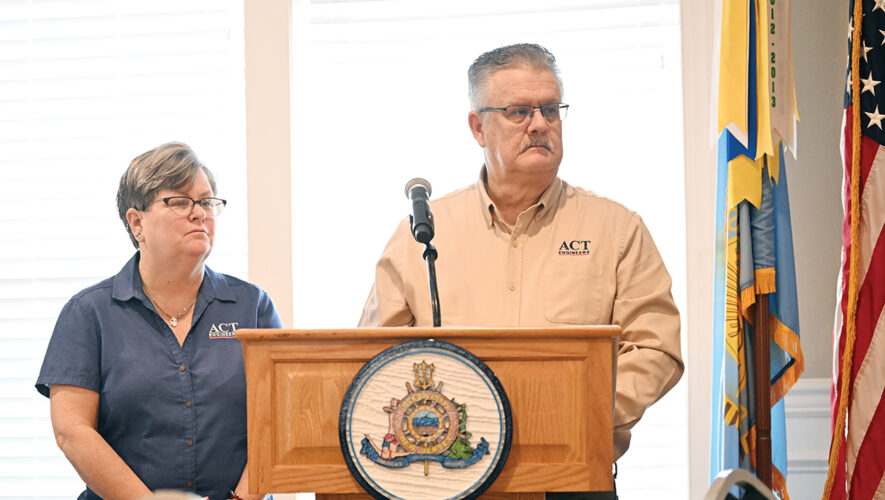Ocean City neighbors ask city to pick up trash and maintain trail
OCEAN CITY — With promises to install a few trash cans and regularly pick up refuse, to protect terrapins and not touch any wetlands, officials from ACT Engineers presented plans for the Crook Horn Creek nature trail project to about 50 citizens Saturday morning, April 5.
They received a generally positive reception.
In a meeting at American Legion Post 524 at 46th Street and West Avenue, ACT’s Junetta Dix and Jeff Richter, directors of environmental services and engineering, respectively, talked about the project to upgrade the trail that runs from 51st Street three-quarters of a mile west to the Intracoastal Waterway. (It is referred to as the West 52nd Street trail because it mainly aligns with 52nd Street before curving north to its terminus at 51st Street.)
ACT Engineers is the firm that secured the grant for the city to do the project, which will take place in the fall and winter after the prime tourism season ends.
Proposed projects on the trail have met significant resistance over nearly two decades, since a bike trail project that would have been built over raised railroad tracks was jettisoned after neighbors’ opposition.
The plan presented Saturday, based on a $580,000 state Department of Transportation grant from 2023, also differed from a more recent version that would have elevated the trail.
This one, according to Dix and Richter, will just level out the trail and overlay it with crushed gravel that will make it handicapped accessible and usable by bikes. It will remain blocked to vehicular traffic.
They said the work on the 10-foot-wide trail will not encroach on any wetlands.
Dix said the project will be beneficial to the city’s ecotourism and has been before the Environmental Commission and they have taken those comments to heart.
There will not be any lighting, it won’t disturb the railroad bed, vegetation or wetlands. Dix called it “a very modest project.”
It will just “reconstruct” the existing trail within its limits, Richter said. “We are not raising the grade,” he said, but would be filling in depressions to make it a level surface.
There will be rest areas every quarter-mile featuring wooden benches with heavy concrete ends and interpretive signage providing information about such things as the marsh and the railroad that used to run through there to the mainland.
After he said there would not be any trash receptacles — just signs advising people to carry out whatever they carry in — the citizens asked that a few be provided because of trash that already gets left there.
Ocean City Business Administrator George Savastano was at the meeting and agreed that not only would a few receptacles be added, but the city would be diligent in emptying them regularly and maintaining the trail.
Citizens had voiced their skepticism over maintenance, citing a lack of it in the past, but Savastano said he would tell the Department of Public Works to inspect it weekly in the summer time.
He noted he lives in the area. “We want to make it nice,” Savastano said. “We will maintain it.”
Under questioning from the public, Dix said no additional parking would be added and Richter said he expected the trail would flood occasionally even though it is above the high tide.
Dix said ACT Engineers, as a consultant to the city, applied for and obtained the grant and did the engineering. She said no environmental permitting was required because there “is no disturbance of wetlands.” She noted the firm is over budget on the project — citing the time taken and all the different revisions — but that ACT would “eat” the excess cost so it would not fall on taxpayers. Dix made a point of saying ACT enjoys doing other pro bono work for the city.
Resident John McNorton emphatically said the city should take advantage of the project.
“If we turn it down, shame on us,” he said, noting he was still upset how the original project was stopped. “Shame on us for not getting the bike path complete.”
He said the city had the opportunity for a bike path but when it fell through his little granddaughters had to ride their tricycles along busy West Avenue.
He also noted that people who worry about the nesting terrapins in the area shouldn’t because Savastano takes special pains to be aware of environmental concerns.
On that note, the ACT representatives were clear that there would be no disruption to turtle habit and breeding. They said work will be done during the fall and winter when terrapins are not active. There will be silt fences to keep any materials from the construction project out of the wetlands, but because they will be up when turtles are not breeding, they won’t block their movement.
City Councilman Sean Barnes asked if there could be curb cuts in the neighborhood or turtle ramps to allow turtles easier access of movement, but Richter said that wasn’t part of the project.
Dix said she has been an environmental consultant for the city for more than 35 years and explained how projects get squashed and reshaped as they evolve. She mentioned the earlier Rails to Trails project that had been proposed, but heard from neighbors who opposed it.
Projects can start out as pipe dreams, but then they have to go through engineering design, budgets, city officials and public comment before they “come up with projects that are palatable to everyone.”
When the transportation grant was received initially in 2023, Savastano said the city presented it to the neighborhood, dovetailing it with a flood mitigation project with an elevated berm, but after they heard concerns from the neighbors, they scaled it back to at-grade with the crushed gravel.
Dix noted the grant is in hand and if the contract isn’t awarded to do the project the city could lose it.
“Shame on us if we don’t take advantage of the grant,” McNorton said.
– STORY and PHOTO by DAVID NAHAN/Sentinel staff



